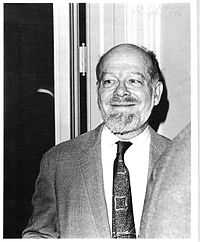Ralph Fox
- This article is about the American mathematician. For the English communist writer, see Ralph Winston Fox.
| Ralph Fox | |
|---|---|
 | |
| Born |
March 24, 1913 Morrisville, Pennsylvania |
| Died |
December 23, 1973 (aged 60) Philadelphia |
| Nationality | American |
| Fields | Mathematics |
| Alma mater |
Princeton University Johns Hopkins University Swarthmore College |
| Doctoral advisor | Solomon Lefschetz |
| Doctoral students |
Herman Gluck Alan Goldman H. W. Kuhn Barry Mazur John Milnor Samuel J. Lomonaco, Jr. John R. Stallings |
| Known for |
Fox n-coloring of knots Fox-Artin arc |
Ralph Hartzler Fox (March 24, 1913 – December 23, 1973) was an American mathematician. As a professor at Princeton University, he taught and advised many of the contributors to the Golden Age of differential topology, and he played an important role in the modernization and main-streaming of knot theory.
Biography
Ralph Fox attended Swarthmore College for two years, while studying piano at the Leefson Conservatory of Music in Philadelphia. He earned a master's degree from Johns Hopkins University, and a Ph.D. degree from Princeton University in 1939. His doctoral dissertation, On the Lusternick-Schnirelmann Category, was directed by Solomon Lefschetz. (In later years he disclaimed all knowledge of Lusternik–Schnirelmann category, and certainly never published on the subject again.) He directed 21 doctoral dissertations, including those of John Milnor, John Stallings, Francisco González-Acuña, Guillermo Torres-Diaz and Barry Mazur.
His mathematical contributions include Fox n-coloring of knots, the Fox-Artin arc, and the free differential calculus. He also identified the compact-open topology on function spaces as being particularly appropriate for homotopy theory.
Aside from his strictly mathematical contributions, he was responsible for introducing several basic bits of terminology to knot theory: the phrases slice knot, ribbon knot, and Seifert circle all appear in print for the first time under his name, and he also popularized (if he did not introduce) the phrase Seifert surface.
He popularized the playing of the oriental game of Go at both Princeton and the Institute for Advanced Study.
Footnotes
Selected publications
- Introduction to Knot Theory, Richard H. Crowell and Ralph H. Fox, Reprint of the 1963 original, Graduate Texts in Mathematics, No. 57, Springer-Verlag, New York-Heidelberg, 1977. ISBN 0-387-90272-4
- "A quick trip through knot theory", in: M. K. Fort (Ed.), Topology of 3-Manifolds and Related Topics, Prentice-Hall, New Jersey, 1961, pp. 120–167. MR 0140099
- Metacyclic invariants of knots and links, Canadian Journal of Mathematics 22 (1970) 193–201. MR 0261584
- "On topologies for function spaces", Bulletin of the American Mathematical Society 51 (1945) 429-432. MR 0012224
External links
- O'Connor, John J.; Robertson, Edmund F., "Ralph Fox", MacTutor History of Mathematics archive, University of St Andrews.
- Ralph Fox at the Mathematics Genealogy Project
- Jozef H. Przytycki, Notes to the early history of the Knot Theory in Japan, 2001.
|